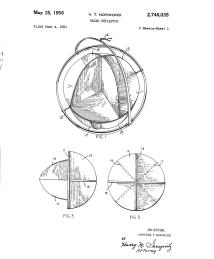Virginia Norwood
Virginia Norwood invented the Multispectral Scanner (MSS), the first in a series of satellite-based instruments that have been continuously imaging our planet for decades. Launched in 1972 aboard Landsat 1, the first satellite designed to study the Earth’s surface, the MSS provided invaluable data and sparked a revolution in remote sensing technology.
Norwood was born in a U.S. Army hospital at Fort Totten in the New York City borough of Queens in 1927. Her mother was a linguist and homemaker, and her father an Army Signal Corps officer with a master’s degree in physics. The family moved many times through Norwood’s early years, from Panama to Oklahoma to Bermuda. Norwood had a natural aptitude for mathematics and developed an interest in physics at a young age. Though her high school guidance counselor suggested she pursue a career as a librarian, her parents encouraged her to study whatever she was interested in.
Staying true to her interests, Norwood enrolled at the Massachusetts Institute of Technology (MIT), the school that she always wanted to attend, where she was one of only a dozen women in her class. At the time, MIT’s few women students had no on-campus housing and only were permitted in the dining halls as guests of male students. Undeterred, Norwood said, “We thought we were in the best school in the world.” She earned her bachelor’s degree in mathematical physics in 1947.
While she initially struggled to find work in her field, she worked for a department store before being hired to teach business arithmetic at a junior college. In 1948, she became a researcher at the U.S. Army Camp Evans Signal Corps Laboratories in New Jersey, and in 1953 she took on a role as a microwave radar researcher at Sylvania Electronic Defense Laboratories in California. In 1954, Norwood joined Hughes Aircraft Co. in California. Here, her roles included leader of the Microwave Group, manager of Earth Resources Requirements in the NASA Systems Division, and senior scientist and laboratory engineer in the Electro-Optics Systems Group — a position she held from 1977 until her retirement in 1989.
In the late 1960s, Norwood began working on a spaceborne multispectral imager, a device that takes in only specific bands of light wavelengths, to support NASA's Earth Resources Technology Satellite (ERTS). The ERTS was designed to observe Earth's surface and provide information on land use and land cover, wildfire spread, algae blooms, melting glaciers, oil spills and more. Norwood surveyed people who would use such images, like resource managers, geologists, agronomists and environmentalists, before designing the MSS. “I had to talk to people in all kinds of disciplines that I had no idea about before, so I found it utterly fascinating,” she recalled. “I tried to get an intersection of their needs and make the optimal specifications for the scanner itself which would satisfy the broadest range of them.”
Norwood’s MSS consisted of an oscillating mirror that repeatedly scanned a swath of land 115 miles wide. The mirror’s light passed through filters onto 24 detectors, resulting in 24 channels of video data processed by a multiplexer. An analog-to-digital converter changed the data to a pulse-code modulated signal that was then transmitted to a ground station. When no station was within range, it stored the data on magnetic tape for later transmission.
The ERTS 1, later renamed Landsat 1, was launched on July 23, 1972. The satellite orbited above the outer limit of Earth's atmosphere and completed its coverage cycle every 18 days. While the Return Beam Vidicon was meant to be the primary instrument, MSS data proved superior. After power surges disabled one of the satellite’s two recorders, the lighter, more photometrically accurate, four-band MSS became the main sensor for the rest of the mission.
With Norwood’s contributions, Landsat 1 became the first satellite to study and monitor Earth’s landmasses. MSS images produced from the green spectral band showed shallow water and water with high sediment loads, the red band showed cultural features like cities and two near-infrared bands showed vegetation patterns, landforms and boundaries between land and water. Each detector measured the amount of sunlight reflected from Earth's surface in a specific wavelength band, pixel by pixel. The strings of pixels were transmitted to Earth and reassembled into images.
MSS instruments were on board Landsat 1 through Landsat 5 and set the standard for quantitative remote sensing. Satellite images have documented the shrinking of the Aral Sea, the growth of megacities, the steady retreat of the world's glaciers, volcanic eruptions and Amazon deforestation rates. Satellite images of wildfires also have taken on particular importance as wildfires have become more common and more intense.
Norwood’s pioneering work has been recognized with awards including the William T. Pecora Award in 1979, and the American Society for Photogrammetry and Remote Sensing Lifetime Achievement Award in 2021. She received the American Geographical Society O.M. Miller Cartographic Memorial Medal, the organization's highest honor, and the United States Geological Survey John Wesley Powell Award in 2022. Norwood was elected to the National Academy of Engineering in 2023.


